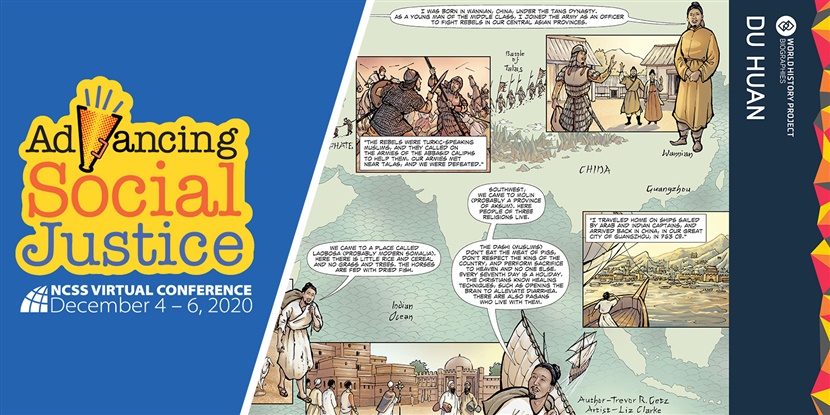By the OER Project Team
While we were really looking forward to a trip to the nation’s capital for this year’s National Council for the Social Studies (NCSS), 2020—as we all know too well—had different plans for us. Despite the move to a virtual format, we were excited to see many faces, familiar and new, in three OER Project sessions during NCSS, December 5 and 6. Here’s a quick recap of the fun!
OER Project teachers contributed to this year’s virtual NCSS conference with two presentations—"Teaching World History with Effective Formative Assessments” and “Forming Compelling Questions: The C3 Arc in Action for the Big History Project.” In addition, Professor Trevor Getz, lead academic adviser for the OER Project, discussed the creation of graphic biographies, which are used in both courses. Don’t worry if you missed the presentations! You can still watch the prerecorded videos for all three talks.
Teaching world history with effective formative assessments
In the WHP video on effective formative assessments, WHP teacher Ane Lintvedt explains helpful strategies for getting students to read visual images by first starting with a current-events cartoon, and then applying the same skills to more-complex historical images such as nineteenth-century cartoons about imperialism. Then, Anne Koschmider explains how to develop students’ claim-testing skills using the WHP Claim Testing—Imperialism activity. Finally, Julianne Horowitz builds upon these tips to highlight how students can then use their visual analysis and claim-testing skills to achieve success in historical writing assessments.
Forming compelling questions: The C3 Arc in action for the Big History Project
For those who teach the Big History Project, Todd Nussen dives into a variety of inquiry practices used in the course, such as developing students’ claim testing and interdisciplinary inquiry skills. BHP teaches students how to ask questions about a variety of scientific and historical topics and respond to historical questions, such as those posed in Investigations, using evidence from the course. Next, Hajra Saeed explains how she has her students work on their inquiry skills using the Little Big History Project. Students choose their topics while Hajra guides them on how to develop good research questions and make connections across the BHP thresholds of increasing complexity. The result? Amazing inquiry-based projects on a wide variety of topics from the history of balloons to ice cream to aircraft.
How to decode a graphic biography
And last but certainly not least, Professor Trevor Getz shares information on how the OER Project incorporates graphic biographies in the courses. The purpose behind using graphic biographies is threefold:
- Students really enjoy reading them because they provide stunning visuals that are packed with information at the smallest scale—a person’s life or the history of an object.
- The graphic biographies allow students to do some scale-switching, as they go from looking at history at larger scales—a century or millennia—to viewing it from the perspective of an individual’s lifetime.
- Using graphic biographies helps students learn to read visual images and examine these images to pull out historical information. This includes analyzing the images of people and objects in the biographies, but also learning how the use of visual imagery in the gutters or borders of the biography help to convey this history.
The best part of these presentations is that they provide practical information! And if you have questions, need even more inspiration, or want to chat with other teachers, you can head over to the OER Project Community to interact with other educators about these topics and much more.
Header image: Composite image of NCSS Virtual Conference logo with OER Project’s graphic biography of Du Huan, a Chinese soldier of the Tang Dynasty who was captured by an Abbasid army. He traveled widely in East Africa and Arabia before returning home.
Looking for more? Join us in the OER Project Community today! And if you aren’t registered with us yet, create an account here for free access to the OER Project Community and more.
 For full access to all OER Project resources AND our amazing teacher community,
For full access to all OER Project resources AND our amazing teacher community, 
